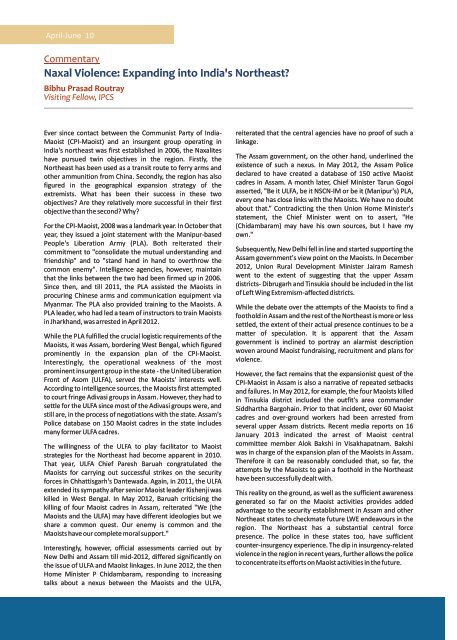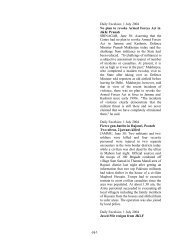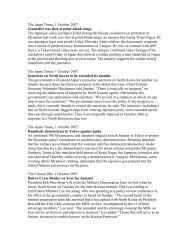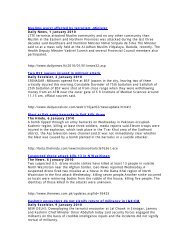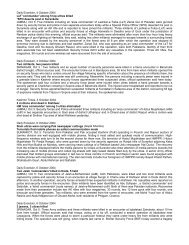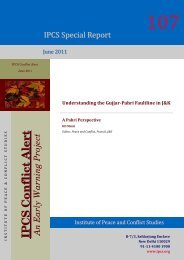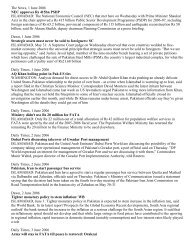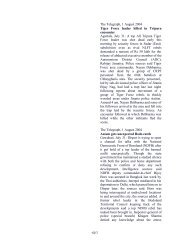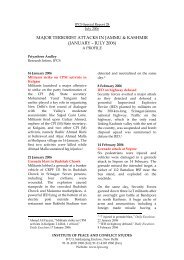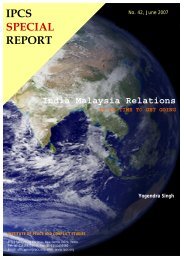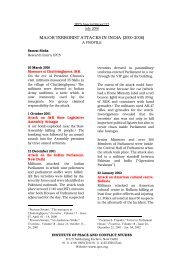April-June 2013 - Institute of Peace and Conflict Studies
April-June 2013 - Institute of Peace and Conflict Studies
April-June 2013 - Institute of Peace and Conflict Studies
You also want an ePaper? Increase the reach of your titles
YUMPU automatically turns print PDFs into web optimized ePapers that Google loves.
<strong>April</strong>-<strong>June</strong> 10<br />
Commentary<br />
Naxal Violence: Exp<strong>and</strong>ing into India's Northeast?<br />
Bibhu Prasad Routray<br />
Visiting Fellow, IPCS<br />
Ever since contact between the Communist Party <strong>of</strong> India-<br />
Maoist (CPI-Maoist) <strong>and</strong> an insurgent group operating in<br />
India's northeast was first established in 2006, the Naxalites<br />
have pursued twin objectives in the region. Firstly, the<br />
Northeast has been used as a transit route to ferry arms <strong>and</strong><br />
other ammunition from China. Secondly, the region has also<br />
figured in the geographical expansion strategy <strong>of</strong> the<br />
extremists. What has been their success in these two<br />
objectives? Are they relatively more successful in their first<br />
objective than the second? Why?<br />
For the CPI-Maoist, 2008 was a l<strong>and</strong>mark year. In October that<br />
year, they issued a joint statement with the Manipur-based<br />
People's Liberation Army (PLA). Both reiterated their<br />
commitment to "consolidate the mutual underst<strong>and</strong>ing <strong>and</strong><br />
friendship" <strong>and</strong> to "st<strong>and</strong> h<strong>and</strong> in h<strong>and</strong> to overthrow the<br />
common enemy". Intelligence agencies, however, maintain<br />
that the links between the two had been firmed up in 2006.<br />
Since then, <strong>and</strong> till 2011, the PLA assisted the Maoists in<br />
procuring Chinese arms <strong>and</strong> communication equipment via<br />
Myanmar. The PLA also provided training to the Maoists. A<br />
PLA leader, who had led a team <strong>of</strong> instructors to train Maoists<br />
in Jharkh<strong>and</strong>, was arrested in <strong>April</strong> 2012.<br />
While the PLA fulfilled the crucial logistic requirements <strong>of</strong> the<br />
Maoists, it was Assam, bordering West Bengal, which figured<br />
prominently in the expansion plan <strong>of</strong> the CPI-Maoist.<br />
Interestingly, the operational weakness <strong>of</strong> the most<br />
prominent insurgent group in the state - the United Liberation<br />
Front <strong>of</strong> Asom (ULFA), served the Maoists' interests well.<br />
According to intelligence sources, the Maoists first attempted<br />
to court fringe Adivasi groups in Assam. However, they had to<br />
settle for the ULFA since most <strong>of</strong> the Adivasi groups were, <strong>and</strong><br />
still are, in the process <strong>of</strong> negotiations with the state. Assam's<br />
Police database on 150 Maoist cadres in the state includes<br />
many former ULFA cadres.<br />
The willingness <strong>of</strong> the ULFA to play facilitator to Maoist<br />
strategies for the Northeast had become apparent in 2010.<br />
That year, ULFA Chief Paresh Baruah congratulated the<br />
Maoists for carrying out successful strikes on the security<br />
forces in Chhattisgarh's Dantewada. Again, in 2011, the ULFA<br />
extended its sympathy after senior Maoist leader Kishenji was<br />
killed in West Bengal. In May 2012, Baruah criticising the<br />
killing <strong>of</strong> four Maoist cadres in Assam, reiterated "We (the<br />
Maoists <strong>and</strong> the ULFA) may have different ideologies but we<br />
share a common quest. Our enemy is common <strong>and</strong> the<br />
Maoists have our complete moral support."<br />
Interestingly, however, <strong>of</strong>ficial assessments carried out by<br />
New Delhi <strong>and</strong> Assam till mid-2012, differed significantly on<br />
the issue <strong>of</strong> ULFA <strong>and</strong> Maoist linkages. In <strong>June</strong> 2012, the then<br />
Home Minister P Chidambaram, responding to increasing<br />
talks about a nexus between the Maoists <strong>and</strong> the ULFA,<br />
reiterated that the central agencies have no pro<strong>of</strong> <strong>of</strong> such a<br />
linkage.<br />
The Assam government, on the other h<strong>and</strong>, underlined the<br />
existence <strong>of</strong> such a nexus. In May 2012, the Assam Police<br />
declared to have created a database <strong>of</strong> 150 active Maoist<br />
cadres in Assam. A month later, Chief Minister Tarun Gogoi<br />
asserted, "Be it ULFA, be it NSCN-IM or be it (Manipur's) PLA,<br />
every one has close links with the Maoists. We have no doubt<br />
about that.” Contradicting the then Union Home Minister's<br />
statement, the Chief Minister went on to assert, "He<br />
(Chidambaram) may have his own sources, but I have my<br />
own."<br />
Subsequently, New Delhi fell in line <strong>and</strong> started supporting the<br />
Assam government's view point on the Maoists. In December<br />
2012, Union Rural Development Minister Jairam Ramesh<br />
went to the extent <strong>of</strong> suggesting that the upper Assam<br />
districts- Dibrugarh <strong>and</strong> Tinsukia should be included in the list<br />
<strong>of</strong> Left Wing Extremism-affected districts.<br />
While the debate over the attempts <strong>of</strong> the Maoists to find a<br />
foothold in Assam <strong>and</strong> the rest <strong>of</strong> the Northeast is more or less<br />
settled, the extent <strong>of</strong> their actual presence continues to be a<br />
matter <strong>of</strong> speculation. It is apparent that the Assam<br />
government is inclined to portray an alarmist description<br />
woven around Maoist fundraising, recruitment <strong>and</strong> plans for<br />
violence.<br />
However, the fact remains that the expansionist quest <strong>of</strong> the<br />
CPI-Maoist in Assam is also a narrative <strong>of</strong> repeated setbacks<br />
<strong>and</strong> failures. In May 2012, for example, the four Maoists killed<br />
in Tinsukia district included the outfit's area comm<strong>and</strong>er<br />
Siddhartha Bargohain. Prior to that incident, over 60 Maoist<br />
cadres <strong>and</strong> over-ground workers had been arrested from<br />
several upper Assam districts. Recent media reports on 16<br />
January <strong>2013</strong> indicated the arrest <strong>of</strong> Maoist central<br />
committee member Alok Bakshi in Visakhapatnam. Bakshi<br />
was in charge <strong>of</strong> the expansion plan <strong>of</strong> the Maoists in Assam.<br />
Therefore it can be reasonably concluded that, so far, the<br />
attempts by the Maoists to gain a foothold in the Northeast<br />
have been successfully dealt with.<br />
This reality on the ground, as well as the sufficient awareness<br />
generated so far on the Maoist activities provides added<br />
advantage to the security establishment in Assam <strong>and</strong> other<br />
Northeast states to checkmate future LWE endeavours in the<br />
region. The Northeast has a substantial central force<br />
presence. The police in these states too, have sufficient<br />
counter-insurgency experience. The dip in insurgency-related<br />
violence in the region in recent years, further allows the police<br />
to concentrate its efforts on Maoist activities in the future.


